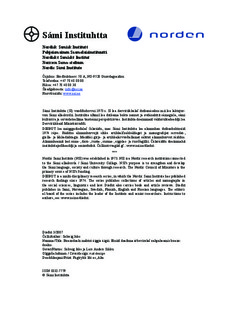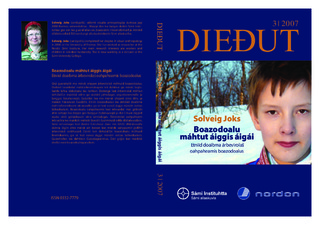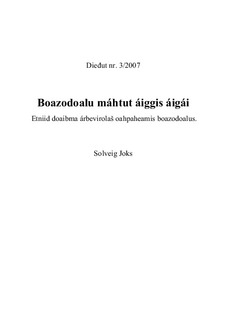| dc.description.abstract | Girji guorahallá mo mánát odne ohppet árbevirolaš máhtuid boazodoalus go eai jođe šat siidda mielde seamma ollu go sullii 40 jagi áigi dahje go 9-jagi skuvla álggahuvvui. Guorahallan lea dahkkon Guovdageainnus, ja dasa lassin leat maiddái dieđut eará boazodoalloguovlluin. Boazodoalu nissonolbmot leat odne guovddážis bajásgeassimin mánáid boazo¬dollui go mánát leat eanaš áigge etniid luhtte skuvlaváccedettiin. Albmát leat dat geat dávjjimusat leat siidadoalus. Ovddeš árbevirolaš siiddastallan mas olles bearaš jođii ovttas, lea nohkan, muhto boazodoalu iežas siskkáldas organiseren lea dattetge bisuhuvvon mealgat muddui rievddakeahttá nugo siidadoalut ja báike¬doalut. Seammás go organiserenmálle bisuhuvvo, de doaimmahuvvojit maiddái seamma barggut nugo guođoheapmi, gárddástallamat, bohccoávdnasiid dikšun ja dasa lassin duddjon. Organiserema ja bargguid mielde čuvvot máhtut, ja nu leage dárbbašlaš daid fievrridit ođđa buolvvaide. Boazodoalu heiveheamit leat leamaš iešguđetlágánat iešguđetge guovlluin. Nuorta-Finnmárkkus omd. leat nissonolbmot leamaš smávvadálolaččat lassin boazodollui juo 1900-logu álgogeahčen. Guovdageainnus ja báikkuid Kárášjogas lea leamaš nomádaeallin mas olles bearaš lea johtán siidda mielde, gitta 1900-logu gaskkamuddui. 1960-logus huksegohte boazosámit dáluid čoahkkebáikkiide Guovdageainnus ja 9-jagi skuvla álggahuvvui. Mánát šadde eanaš áigge leat skuvllas, ja eatnit maiddái ássagohte čoahkkebáikkiide. Mánáid lunddolaš oahppan beaivválaš bargguid bokte unnui.Mánát ohppet dávjá bargguid bokte daid guovlluin gos boazodoallu doaimmahuvvo. Eatnit boazodoalus leat guovddážis máhttofievrrideamis go mánát leat eanaš áigge sin luhtte báikedoaluin. Dávjá leat maiddái eatnit lágideamen mánáid siidadollui. Boazodoalu siskkobealde leat iešguđetlágán máhtut go dilálašvuođat leat máŋggalágánat. Suolohasain lea mearra maid rasttildit ja mii dagaha ahte sii dárbbašit earálágán máhtuid go omd. nannánorohagat. Boazo¬doallomáhttu lea máhttu maid dávjá ferte oahppat doppe gos doaibma lea, go dilálašvuođat gáibidit iešguđetlágán čovdosiid. Olmmoš vásihage dilálaš¬vuođaid mat eai leat ovttaláganat, ja nu eai gávdnoge čavga njuolggadusat álo dasa mo čoavdit čuolmmaid. Oahpaheapmi láhččojuvvo nu ahte mánná beassá ieš vásihit dilálašvuođaid ja oahppat oaidnima bokte gávdnat čovdosiid. Boazodoalus leage dehálaš oahppat oaidnit, dovdat ja dádjadit. Seamma láhkái go muitalusat ja diiddat eai leat njuolggosánálaččat, de maiddái oahppan dávjá dáhpáhuvvá geažideami bokte. Muitalusat ja diiddat doibmet morálalaš neavvun mánáide, ja muitalusaid bokte ealáskahttojuvvojit guovllut, ja olbmot geat leat mielde muitalusain muittašuvvojit. Boazodoalu giella lea mávssolaš go omd. okta sátni sáhttá sisttisdoallat oalle dárkilis čilgehusa. Mánná oahppá buoremusat go lea doppe gos barggut doaimmahuvvojit. Sámegielas leatge ollu sánit mat gusket duovdagiidda ja main leat dárkilis čilgehusat nugo omd. bohcco ealiheamis ja johtolagas. Giella doaibmá maid gulahallamis, jus dan ii hálddaš de geanohuhttá dat gulahallama eará boazobargiiguin.Boazodoallomáhttu lea árbevirolaš máhttu, ja dan dovdomearka lea ee. ahte máŋggalágan máhtut sáhttet oahpahuvvot oktanaga. Vuoiŋŋalaš máhttu omd. sáhttá oahpahuvvot geavatlaš bargguid olis. Nubbi dovdomearka lea ahte máhttu fievrriduvvo doppe gos barggut doaimmahuvvojit. Dát bealit dagahit ahte lea veadjemeahttun fievrridit boazodoalu ollislaš oahpaheami skuvlii. Boazo¬doallo¬máhtut leat dattetge dehálaččat doallevašvuođa geažil, ja servodat berrešii danne ságastallat mo máhtu seailluhit boahtteáiggis. ************************************************************************************************* The book examines how children, at present, learn the traditional skills needed in reindeer herding, as they no longer follow the herd and the herders – the siida – in the same way as about forty years ago when the 9-year-long school – the compre¬hensive school – was launched. This research has been done in Guovda¬geaidnu (Kautokeino), but it also contains information from other reindeer-herding areas.The women who are involved in reindeer husbandry play at present a central role in training children for reindeer herding, since the children mainly stay with their mothers when going to school. Men are the ones who mostly work with the reindeer. The former, traditional way of herding reindeer in which the whole family moved together is no longer practised, but the inner organization of reindeer husbandry, the system of siidadoallu and báikedoallu – is, to a great extent, unchanged. With an unchanged organization, the tasks, such as tending the reindeer, round-ups, taking care of all the material that the reindeer yields and making handicraft, also stay the same. The herding skills are learnt through organization and the performing of tasks, and they need to be passed down to new generations.In different areas, there have been local variations of reindeer herding. In Eastern Finnmark, for example, women were, to some extent, engaged in farming in addition to reindeer herding as early as the beginning of the 1900s. In Guovdageaidnu and in some parts of Kárášjohka (Karasjok), reindeer herding was nomadic in nature and the whole family migrated with the herd until the mid-1900s. In the 1960s, reindeer-herding Sámi began building houses into the villages in Guovdageaidnu and the 9-year-long comprehensive school was launched. Children ended up in being most of the year at school, and mothers also began to settle in the population centres. Children no longer learnt as much in a natural way, by performing every-day tasks.In reindeer-herding areas, it is typical for children to learn by doing. The mothers who are active in reindeer herding play an important role in passing down the skills to their children, as the children mostly live with them in the population centres. Often, the mothers also do all the preparations so that the children can go to the siida and engage in reindeer work.Because of differences in herding conditions, the skills of the herders vary from place to place. Some herders cross parts of the sea when migrating with their herds to islands, and, therefore, they need different kinds of skills than the herders who stay on the mainland. The reindeer-herding knowledge consists of skills that one often needs to learn on the spot where the activities take place, as the conditions determine how to proceed. Indeed, conditions vary, and, therefore, it is not possible to decide in advance how to solve problems. Learning happens so that children are themselves involved in the different situations; thus, they learn, through experience, to find solutions. Indeed, it is important in reindeer herding to learn to see, know, cope and find one’s way. In the same way as narratives and beliefs tell nothing explicitly, learning also happens often through tips and hints. Stories and beliefs function as moral guidance for children, and, through narration, places become alive and people who are part of the stories are remembered. The language used in reindeer herding is important, as one word can, for example, contain an explanation that is rich in detail. A child learns best by being around when activities take place. The Sámi language abounds in words that are connected with and explain in detail the landscape and, for example, the care and routes of the reindeer. Language is also a means of communicating: not knowing it makes it harder to communicate with other herders.Reindeer-herding knowledge is traditional knowledge, and one of its characteristics is that a variety of skills can be taught simultaneously. For example, spiritual knowledge can be taught in connection with practical work. Another characteristic is that skills are passed down through doing. Therefore, it is impossible to train people for reindeer herding just at school. Still, in terms of sustainable development, reindeer-herding knowledge is important, and, thus, we should discuss how to maintain this knowledge in future. | no_NO |



